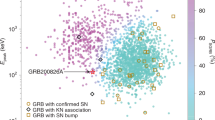Abstract
The INTernational Gamma-ray Astrophysics Laboratory (INTEGRAL) has detected the Short Gamma-Ray Burst (SGRB), GRB170817A with a signal-to-noise ratio of 4.6 and demonstrated its association with the binary neutron star merging event GW170817 detected by the LIGO and Virgo gravitational wave observatories. The association was immediately evident due to the timing and positional coincidence of this event with the initial error box, derived from gravitational wave (GW) measurements and the contemporaneous detection of a similar gamma-ray signal by Fermi/GBM. This SGRB was detected by the INTEGRAL SPI ACS about 1.7 s after the end of the GW emission, with a fluence of (\(1.4 \pm 0.4\)) \(\times 10^{-7} \text { erg cm}^{-2}\) in the 75–2000 keV energy range. After the serendipitous detection of the short prompt GRB, INTEGRAL continued the planned observation for about 20 h, and then performed a targeted follow-up ToO observation lasting several days. This ToO observation provided a stringent upper limit on any electromagnetic signal in a very broad energy range, from 3 keV to 8 MeV, in particular constraining the soft gamma-ray afterglow flux to \(< 7.1 \times ^{-11} \text { erg cm}^{-2} \text { s}^{-1}\) in the range 80–300 keV. Exploiting the unique capabilities of INTEGRAL, we constrained the gamma-ray line emission intensity from radioactive decays expected to be the principal source of the energy behind a kilonova event following a NS–NS coalescence. Finally, we put a stringent upper limit on any delayed bursting activity, for example, from a newly formed magnetar. The INTEGRAL prompt detection and the subsequent continuous observations at all wavelengths have provided important constraints on the high energy emission of the resulting kilonova and the post inspiral object: NS, BH, or a new exotic object.



Similar content being viewed by others
References
Abbott BP (2016) Supplement, localization and broadband follow-up of the gravitational-wave transient GW150914. ApJL 826:L13
Abbott BP (2017) Gravitational waves and gamma-rays from a binary neutron star merger: GW170817 and GRB 170817A scientific collaboration and virgo collaboration, Fermi Gamma-ray Burst Monitor, and INTEGRAL. ApJL 848:L13
Abbott BP et al (2016) Localization and broadband follow-up of the gravitational-wave transient GW150914. ApJ 826L:13
Abbott BP et al (2017a) GW170817: observation of gravitational waves from a binary neutron star inspiral. PRL 119:161101
Abbott BP et al (2017b) Multi-messenger observations of a binary neutron star merger. ApJ 484:12
Band (1993) BATSE observations of gamma-ray burst spectra. I. Spectral diversity. ApJ 413:281
Forot M et al (2007) Compton Telescope with a Coded Aperture Mask: Imaging with the INTEGRAL/IBIS Compton Mode ApJ 668:2
Goldstein A (2017) An ordinay short gamma-ray burst with extraordinary implications: fermi-GBM detection of GRB 170817A. ApJL 848:L14
Labanti C et al (2003) The Ibis-Picsit detector onboard Integral. A&A 411:L149
Lebrun F et al (2003) ISGRI: the INTEGRAL soft gamma-ray imager. A&A 411:L141
Lund N et al (2003) JEM-X: the X-ray monitor aboard INTEGRAL. A&A 411:L231
Mas-Hesse M et al (2003) OMC: an optical monitoring camera for INTEGRAL. A&A 411:L19
Mereghetti S et al (2018) INTEGRAL results on the electromagnetic counterparts of gravitational waves. J Ital Astron Soc (Mem.SAIt) (in press)
Mooley P et al (2018) A mildly relativistic wide-angle outflow in the neutron-star merger event GW170817. Nature 554:207
Quadrini EM et al (2003) IBIS veto system: background rejection, instrument dead time and zoning performance. A&A 411:L153
Rodi J et al (2018) INTEGRAL observation of GW gamma-ray counterparts and future perspectives: searching for GBM un-triggered SGRB with PICsIT, GRAvitational-waves Science and technology Symposium—GRASS2018 (in prep)
Savchenko V et al (2016) INTEGRAL upper limits on gamma-ray emission associated with the gravitational wave event GW150914. ApJ 820:36
Savchenko (2017) INTEGRAL detection of the first prompt gamma-ray signal coincident with the gravitational-wave event GW170817. ApJ 848:15
Savchenko V et al (2017a) INTEGRAL IBIS, SPI, and JEM-X observations of LVT151012. A&A 603:46
Savchenko V et al (2017b) INTEGRAL observations of GW170104. ApJ 846:23
Savchenko V et al (2017c) LIGO/Virgo G297595: INTEGRAL search for a prompt gamma-ray counterpart. GCN Cir 21478
Troija A (2017) The X-ray counterpart to the gravitational-wave event GW170817. Nature 551:71
Ubertini P et al (2003) IBIS: The Imager on-board INTEGRAL. A&A 411:L131
Vedrenne G et al (2003) SPI: The Spectrometer aboard INTEGRAL. A&A 411:L63
von Kienlin A et al (2003) INTEGRAL spectrometer SPI’s GRB detection capabilities. GRBs detected inside SPI’s FoV and with the anticoincidence system ACS. A&A 411:299
Winkler C et al (2003) The INTEGRAL mission. A&A 411:L1
Acknowledgements
This work is based on observations with INTEGRAL, an ESA project with instruments and science data center funded by ESA member states (especially the PI countries: Denmark, France, Germany, Italy, Switzerland, Spain), and with the participation of Russia and the USA. The INTEGRAL SPI project has been completed under the responsibility and leadership of CNES. The SPI ACS detector system has been provided by MPE Garching/Germany. The SPI team is grateful to ASI, CEA, CNES, DLR, ESA, INTA, NASA, and OSTC for their support. The Italian INTEGRAL team acknowledges the support of ASI/INAF agreement No. 2013-025-R.1. R.D. and A.v.K. acknowledge the German INTEGRAL support through DLR Grant 50 OG 1101. A.L. and R.S. acknowledge the support from the Russian Science Foundation (Grant 14-22-00271). A.D. is funded by Spanish MINECO/FEDER Grant ESP2015-65712-C5-1-R. We acknowledge the continuous support by the INTEGRAL Users Group and the exceptionally efficient support by the teams at ESAC and ESOC for the scheduling of the targeted follow-up observations.
Author information
Authors and Affiliations
Corresponding author
Additional information
Publisher’s Note
Springer Nature remains neutral with regard to jurisdictional claims in published maps and institutional affiliations.
This paper is the peer-reviewed version of a contribution selected among those presented at the Conference on Gamma-Ray Astrophysics with the AGILE Satellite held at Accademia Nazionale dei Lincei and Agenzia Spaziale Italiana, Rome on December 11–13, 2017.
Rights and permissions
About this article
Cite this article
Ubertini, P., Bazzano, A., Natalucci, L. et al. INTEGRAL search for GW counterparts and the GRB170817A/GW170817 detection. Rend. Fis. Acc. Lincei 30 (Suppl 1), 65–70 (2019). https://doi.org/10.1007/s12210-019-00767-y
Received:
Accepted:
Published:
Issue Date:
DOI: https://doi.org/10.1007/s12210-019-00767-y




